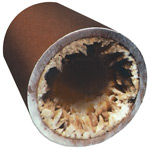What's in Hard Water?
Hard water contains dissolved calcium and magnesium ions. Water picks up these minerals as it flows through layers of soil and rock, it dissolves everything it touches including minerals, and holds them in solution. As the levels of calcium and magnesium increase the water becomes harder, and more difficult to use. Commonly referred to as "hardness minerals," dissolved calcium and magnesium is what created the numerous caverns in the San Antonio area.
However, these same minerals can cause numerous problems  when present in the pipes of your water supply. Hard water causes scaling, which is the left over mineral deposits that are formed after the hard water had evaporated. This is also known as lime scale. The scale can clog pipes, ruin water heaters, coat the insides of tea and coffee pots, and decrease the life of toilet flushing units.
Whether it's from a well or a municipal water utility, water usually contains these troublesome elements; results from the U.S. Geological Survey indicate that 85 percent of American homes are supplied with hard water.
when present in the pipes of your water supply. Hard water causes scaling, which is the left over mineral deposits that are formed after the hard water had evaporated. This is also known as lime scale. The scale can clog pipes, ruin water heaters, coat the insides of tea and coffee pots, and decrease the life of toilet flushing units.
Whether it's from a well or a municipal water utility, water usually contains these troublesome elements; results from the U.S. Geological Survey indicate that 85 percent of American homes are supplied with hard water.
Water hardness is typically measured in "grains per gallon," an indication of the quantity of dissolved calcium and magnesium the water contains. In amounts as small as one grain per gallon, water is classified as "hard" to a certain degree. Most homes use water that is considerably harder.
Hard Water Problems
Hard Water can be responsible for deposits encrusting scale in plumbing and water using appliances; that scale build up can increase energy bills by 25% or more! It can reduce your flow capacity, decreases the efficiency of the heater, and increases energy needed to heat water. Hard water requires additional cleaning chemicals to remove it..
Hard Water is responsible for most of your:
- Mineral spots
- Premature replacment of clothing, due to "hard water"
- Purchase of expensive cleaners that don't seem to work
- Valuable time spent scrubbing calcium off plumbing fixtures
- Expensive bottled water
- Dinginess or graying, yellowing
- General soil build-up
- Stiff, harsh feel to fabrics
- White or gray streaks on colored fabrics
- Yellowing, especially when chlorine bleach is used
- Reduces the efficiency of water-using appliances
These are just a few examples that consume your Time and Money
